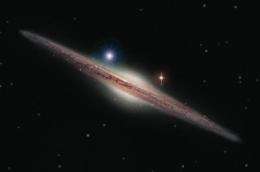New class of black holes discovered

A new class of black hole, more than 500 times the mass of the Sun, has been discovered by an international team of astronomers.
The finding in a distant galaxy approximately 290 million light years from Earth is reported today in the journal Nature.
Until now, identified black holes have been either super-massive (several million to several billion times the mass of the Sun) in the centre of galaxies, or about the size of a typical star (between three and 20 Solar masses).
The new discovery is the first solid evidence of a new class of medium-sized black holes. The team, led by astrophysicists at the Centre d'Etude Spatiale des Rayonnements in France, detected the new black hole with the European Space Agency's XMM-Newton X-ray space telescope.
"While it is widely accepted that stellar mass black holes are created during the death throes of massive stars, it is still unknown how super-massive black holes are formed," says the lead author of the paper, Dr Sean Farrell, now based at the Department of Physics and Astronomy at the University of Leicester.
He added: "One theory is that super-massive black holes may be formed by the merger of a number of intermediate mass black holes. To ratify such a theory, however, you must first prove the existence of intermediate black holes.
"This is the best detection to date of such long sought after intermediate mass black holes. Such a detection is essential. While it is already known that stellar mass black holes are the remnants of massive stars, the formation mechanisms of supermassive black holes are still unknown."
"The identification of HLX-1 is therefore an important step towards a better understanding of the formation of the super-massive black holes that exist at the centre of the Milky Way and other galaxies."
A black hole is a remnant of a collapsed star with such a powerful gravitational field that it absorbs all the light that passes near it and reflects nothing.
It had been long believed by astrophysicists that there might be a third, intermediate class of black holes, with masses between a hundred and several hundred thousand times that of the Sun. However, such black holes had not been reliably detected until now.
This new source, dubbed HLX-1 (Hyper-Luminous X-ray source 1), lies towards the edge of the galaxy ESO 243-49. It is ultra-luminous in X-rays, with a maximum X-ray brightness of approximately 260 million times that of the Sun.
The X-ray signature of HLX-1 and the lack of a counterpart in optical images confirm that it is neither a foreground star nor a background galaxy, and its position indicates that it is not the central engine of the host galaxy.
Using XMM-Newton observations carried out on the 23rd November 2004 and the 28th November 2008, the team showed that HLX-1 displayed a variation in its X-ray signature. This indicated that it must be a single object and not a group of many fainter sources. The huge radiance observed can only be explained if HLX-1 contains a black hole more than 500 times the mass of the Sun. No other physical explanation can account for the data.
Source: University of Leicester (news : web)
















